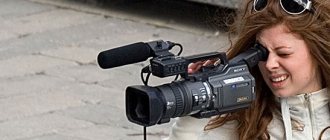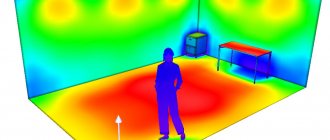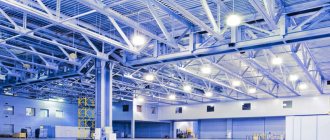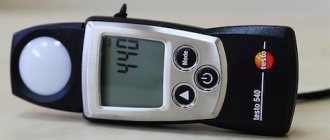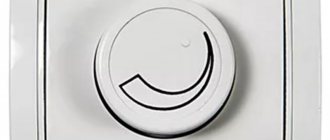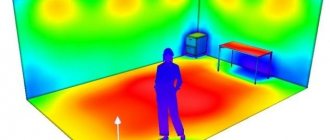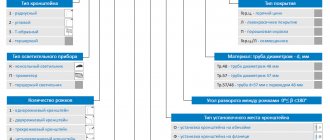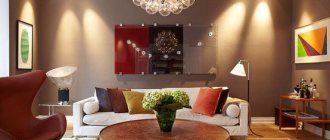Main characteristics of light
A person sees a spectrum of colors - a small part of the range of electromagnetic waves. Its characteristics affect the comfort of the living environment and human well-being. There is a definition for one of the properties - luminous flux (F), which is measured in lumens (lm). The power of the luminous flux of the source characterizes the evoked sensation of light perception. According to its distribution, light flows are distinguished for a closed space: direct, diffused, reflected. The more light, the higher the number of lumens.
Important! This parameter does not determine the intensity, brightness or performance of the glow, because it takes into account the entire diffuse flux. In order to measure the luminous flux it takes a lot of time and it is necessary to take into account the spatial characteristics of the phenomenon
Basic characteristics of light emissions
The main characteristic of the source is the luminous intensity (I), which determines the intensity of radiation in the direction of the flow. It is calculated through the quotient of the luminous flux (Ф) and the solid angle (ꭥ) in steradians (sr), within which it is distributed. In SI, the unit of luminous intensity, the candela, is denoted cd.
Solid angle
Important! A wax candle emits about one candela (from the Latin candela), and previously this unit of measurement was called a “candle”
The candelas value shows the light emission of a point light source in its most intense direction.
Lamp buyers usually rate brightness by the power consumption (W) of the source. With good brightness, you get a clear and contrasting vision of objects. However, both weak and very bright light is unfavorable for human activity. Brightness (L) is determined by the luminous intensity density in the direction of the surface and is calculated by dividing I by the area of projection onto a perpendicular surface (depending on the cos angle).
The brightness index (L) of light is measured in cd/m². The main characteristic of the perception of light sensation by the eyes is the brightness of the illuminated surface or source.
Light units
Luminous efficiency (H) measures the efficiency of converting electrical power into light. During the transition from electrical energy to light, losses appear, which causes a decrease in the brightness of the radiation. Light output is measured in lumens per watt. You can calculate the luminous flux by knowing the average luminous efficiency.
LED lamps have practical light output (losses less than 5%).
Important! There are quality standards for lighting for indoors, as well as for plants or animals. Illumination is characterized by the ratio of luminous flux to surface area
Lighting units
Workplace illumination
Lighting is extremely important for humans. With the help of vision, a person receives most of the information (about 90%) coming from the surrounding world. Light is a key element in our ability to see, evaluate the shape, color and perspective of objects around us. Lighting affects not only the functioning of the visual apparatus, that is, it determines visual performance, but also the human psyche and emotional state. Researchers have accumulated a significant amount of data on the biological effects of visible light on the body. A comparative assessment of natural and artificial lighting based on its effect on performance shows the advantage of natural light. The leading factor determining the biological inadequacy of natural and artificial light is the difference in the spectral composition of radiation, as well as the dynamism of natural light during the day.
Workplace illumination
When working under poor quality or low levels of lighting, people may experience eye fatigue and fatigue, leading to decreased performance. In some cases, this can lead to headaches. The reasons in many cases are too low light levels, glare from light sources and brightness ratios that are not well balanced in the workplace. Headaches can also be caused by lighting pulsation, which is mainly a result of the use of electromagnetic ballasts for discharge lamps operating at a frequency of 50 Hz. From an occupational safety point of view, visual ability and visual comfort are extremely important.
In order to provide the conditions necessary for visual comfort, the lighting system must meet the following prerequisites:
- sufficient and uniform lighting
- optimal brightness
- no glare or glare
- appropriate contrast
- correct color scheme
- no stroboscopic effect or light pulsation
Each type of activity requires a certain level of illumination in the area where this activity is carried out. Typically, the more visually impaired, the higher the average light level should be. It is important to consider light in the workplace, guided not only by quantitative, but also by qualitative criteria.
The following quality characteristics of lighting and ways to improve them can be identified:
Direct shine
High-brightness surfaces within a person's field of vision can produce an unpleasant, uncomfortable sensation or cause a state of blindness. As a result, visual performance decreases sharply. Sources of direct glare are lighting installations and light sources.
Direct gloss reduction can be achieved:
- increasing the installation height of lamps
- reducing the brightness of lamps by covering light sources with light-diffusing glass
- limiting the light intensity in directions forming large angles with the vertical, for example, using lamps with the required protective angle
- reducing the power of each individual lamp due to a corresponding increase in their number
Reflected gloss
Occurs when the reflection coefficients of surfaces falling into the field of view are high. The greatest danger arises when illuminating surfaces that are not diffuse, when the light falls on the working surfaces in such a way that the eyes are in the direction of specular reflection of the rays. In this case, a person sees either a mirror reflection of the light source or a blurry but very bright spot of light. In both cases, a state of blindness may occur, but more often the effective contrast between the detail and the background is reduced. Elimination of reflected glare is achieved by the correct organization of localized lighting and the arrangement of lamps so that the rays specularly reflected by the surface do not enter the eyes. To do this, it is best to do the lateral or posterolateral direction of the light.
Contrast between subject and background
The brighter the object, the greater the light flux from it enters the eye and the stronger the signal coming from the eye to the visual center. Thus, it would seem that the greater the brightness, the better a person sees the object. However, this is not quite true. If the surface (background) on which the object is located has a brightness close to the object (for example, a pale yellow line on a white sheet), then the intensity of illumination of the retinal areas by the light flux coming from the background and the object is the same (or slightly different ), the magnitude of the signals entering the brain is the same, and the object against the background becomes indistinguishable.
For an object to be clearly visible, the brightness of the object and the background must be different. The difference between the brightness of the object and the background, divided by the brightness of the background, is called contrast. The contrast between details and background, which most determines the visibility of an object, is not always given and can be increased or decreased by means of lighting and the creation of a light environment. One effective means of increasing contrast is an artificial background (usually light if the subject is dark, or dark if the subject is light). A variety of artificial backgrounds are light tables, on which surfaces are viewed in transmitted light.
Shadows
A distinction is made between intrinsic shadows formed by the surface topography and shadows falling from objects located outside the working surface - equipment, furniture, human body and hands, etc. In most cases, intrinsic shadows are useful because they allow you to better distinguish the configuration of a part. Falling shadows are almost always harmful. Their harm lies in the fact that they distort contrast, distract attention, etc. Moving shadows are especially harmful. Eliminating or limiting harmful shadows is achieved by choosing the correct direction of light. For example, when a person writes with his right hand, he looks at the working point on the left and the light should fall from the same side. Shadows blur as the size of lighting installations increases, soften when the brightness of walls and ceilings is high enough, and almost disappear with indirect lighting.
Saturation of the room with light
To create comfortable visual conditions for a person, it is important not only the illumination of any surface on which work is carried out, but also the impression that a person receives of the saturation of the room with light. Even if the working surface is sufficiently bright, the simultaneous presence of dark surfaces in the field of vision (for example, walls, ceilings, furniture, equipment) creates difficulties in adapting vision. The brightness of these surfaces determines the impression of light saturation in the room. If the room has direct light pendant lights, the upper area of the room will remain dark. This produces an unpleasant aesthetic and psychological impression. Therefore, it is better to use light colors for walls and ceilings, and for lighting use lamps that emit some (preferably at least 15%) part of the light flux into the upper hemisphere.
Consistency of illumination over time
Changes in illumination over time can be divided into slow and smooth, frequent fluctuations and pulsations. Slow changes are caused by gradual changes in the mains voltage and factors that change the illumination during operation (pollution of light sources, decreased light output, etc.). If the illumination remains at a level not lower than the standard value, these changes are not harmful. The reason for frequent fluctuations is the movement of lamps, their swinging by air movement (wind, draft, ventilation unit, etc.) and voltage fluctuations in the network generated by changes in load.
Ripple
Illumination pulsations are due to the low inertia of the radiation of gas-discharge lamps; the light flux pulsates with alternating current of industrial frequency (50 Hz) with a double frequency - 100 Hz. These pulsations are indistinguishable when observing a stationary surface with the eye, but are easily detected when examining moving objects. If, under pulsating lighting, you quickly wave a pencil against a contrasting background, the pencil acquires clearly visible contours. This phenomenon is called the stroboscopic effect - the phenomenon of distortion of the perception of moving or rotating objects of observation. A practical danger of the stroboscopic effect is that rotating parts of machinery may appear to be stationary, rotating at a slower speed than they actually are, or in the opposite direction. This may cause injury. However, pulsating illumination is also harmful when working with stationary surfaces, causing visual fatigue and headaches.
Peripheral vision is most sensitive to pulsations and therefore they are dangerous in general lighting. An unfavorable effect of light fluctuations on the photoreceptor elements of the retina, as well as on the functional state of the nervous system, was also revealed, which is associated with the development of inhibitory processes and a decrease in the lability of nervous processes. The impact of pulsation increases with increasing depth and decreases with increasing frequency. Most researchers note the negative impact of pulsating illumination on human performance, both during long-term exposure to pulsating lighting conditions and during short-term exposure.
Limitation of ripple is achieved by alternating the supply of lamps from different phases of a three-phase network. In some cases, lamps are powered with high-frequency current, which is achieved by equipping lamps with electronic ballasts.
How to Convert Luxes to Lumens
However, if you know the required illumination value in lux and the area of the illuminated surface, you can calculate the required luminous flux in lumens. It should be understood that the calculation will be performed with many assumptions, since it is not possible to bring the conditions for its implementation closer to physically ideal ones. When calculating, it should be assumed that:
- the light source is located in the center;
- the illumination is uniform over the entire area, which is practically impossible;
- light falls on the entire surface area at the same angle;
- the surface is illuminated from within the mental sphere supposed to surround the source.
In order to get the value in lumens, you need to multiply the standard in lux by the value of the area that needs lighting.
The floor and ceiling area will be: 10 x 10 = 100 m². Area of each wall: 4 x 10 = 40 m². Theoretically, with the assumption of uniform illumination and the location of the source, equidistant from all points of the surface, the problem is solved as follows: 300 lux x (4 x 40 + 100 + 100) m² = 300 x 360 = 108,000 lm. If this astronomical value is “translated” into ordinary 100-watt incandescent lamps, then you will only need... 72 pieces.
The practical approach will be different. There is absolutely no need to illuminate the ceiling - employee workplaces are located below. Moreover, the design of many ceiling lights makes it impossible for light to spread upward. This means you need to remove the ceiling area from the calculations:
300 lux x 260 m² = 78,000 lumens.
Modern LED ceiling lights can produce 5,000 lumens. Accordingly, 16 pieces (78,000/5000) will be required, rounded to the nearest whole number.
This number can be reduced. According to SanPiN 2.2.1/2.1.1.1278-03, illumination is measured above the working surface, as well as at control points 1 m away from walls and light openings. It is enough to place lighting fixtures above employees’ workplaces. Mathematically reducing the geometric characteristics of the floor by 1 m on each side, we get:
300 lx x (160 + 64) m² = 300 x 224 = 67200 lm. What in the ceiling lights will be: 14 pieces, rounded to the nearest whole number.
Watch this video on YouTube
Regulatory regulation
Issues of labor standardization are primarily regulated by labor legislation . However, Art. 163 of the Labor Code of the Russian Federation speaks only about the employer’s obligation to provide its employees with the appropriate condition of the premises, and Art. 211 – about who sets the Standards. The articles of Federal Law No. 52 “On the sanitary and epidemiological welfare of the population” are also descriptive in nature.
Lighting standards are enshrined in more specific regulations - Sanitary Rules and Norms (SanPiN). Let us dwell on four Resolutions :
- SanPiN 23-05-95 “Natural and artificial lighting”.
- SanPiN 2.2.4.3359-16 “Sanitary and epidemiological requirements for physical factors in the workplace” (Table P 9.2).
- SanPiN 2.2.2.1332-03 “Hygienic requirements for organizing work on copying equipment” (Section VIII).
- SanPiN 2.2.0.555-96 “Hygienic requirements for working conditions for women.”
The listed rules establish illumination standards and methods for their calculation, which are specified in GOST R 555710-2013. The act also contains normative references that refer to the standards used in the document (methods for measuring discomfort under artificial lighting, measurement methods, etc.).
Norms and calculation procedure
Lighting requirements depend on the purpose of a particular room and the type of human activity. The standards by which the indicator is measured are established in GOST R 54944-2012, the norms are in SNiP. All parameters apply not only to the floor, but also to the planes of the tables. Tables are available that can be used to determine lux for any property.
When developing a lighting system for a residential building (apartment), you can use the data from this table:
| Standard according to SNiP (LK) | Room |
| 20 | Passages to attics, basements |
| 20 | Electrical switchboards, boiler rooms, ventilation chambers |
| 20 | Stairs |
| 50 | Bathrooms. showers, toilets |
| 50 | Corridors and halls in houses (apartments) |
| 75 | Wardrobe rooms |
| 100 | Saunas, locker rooms, swimming pools |
| 150 | Living rooms and kitchens |
| 150 | GYM's |
| 200 | Children's rooms |
| 300 | Libraries, offices |
The calculation is carried out in 2 stages:
- determining the required level of luminescence;
- determining the number of light bulbs.
Formula for calculating the glow:
N*P*K, where:
N – norm (according to the table);
P – room area;
K – coefficient depending on the height of the ceilings (1 for 2.5-2.7 m, 1.2 for 2.7-3 m, 1.5 for 3-3.5 m, 2 for 3.5-4, 4 m).
To calculate the number of lamps, the result must be divided by the lumens indicated in the technical documentation of the lamps selected for installation.
If major repairs or reconstruction work is carried out, the contractor’s employees handle the calculations.
They take into account the design features and materials of lamps, light reflection from walls, floors, ceilings, and interior items, depending on the characteristics of the facing material. The type of lamps is preliminarily indicated in the design documentation and technical specifications.
The formula used for calculations is:
K=(E*k*S*k1)/(F*k2), where:
E – norm for horizontally located planes;
k – coefficient calculated taking into account deviations in the operation of the system when individual light sources burn out and interior items move;
S – area of the room;
k1 – coefficient of unevenness;
Ф – luminous flux from one light bulb (depending on power and type);
k2 – coefficient in shares.
When carrying out measurements and calculations yourself, it should be taken into account that reflected light in power may differ little from direct light.
What should be the lighting for the workplace in various types of offices?
The measurement is made in lux (lx). This value is often confused with lumens (lm). Lx directly measures illumination, while lm characterizes the light source itself. SanPiN 05/23/95 established the following standards for offices :
- office work, reception rooms, including the use of computer technology - 200-300 lux;
- for working with drawings – 500 lux;
- with a large area - 400 lux;
- archives – 75 lux;
- storage rooms – 50 lux;
- conference room – 200 lux;
- stairs – 50-100 lux;
- corridors and hall – 50-75 lux.
Calculation of luminous flux
In order to understand the required luminous flux parameter and calculate the number of LED lamps in the room, it is necessary to multiply the standard sanpin indicator by the area of the room and the coefficient taking into account the ceiling height (for a ceiling of 2.7 meters it is 1, and for 3 meters it is 1.2). As a result, it turns out that 150 lux are needed to illuminate the kitchen and bedroom, 350 lux for the office, and 50 lux for the bathroom and hallway.
Further, when calculating, you should rely on the power of the light sources, expressed in lumens. The resulting value according to the formula should be divided by the power of the lamps and their number will be obtained.
Note! To correctly calculate the power of the luminous flux, you need to use the formula for the ratio of specific power per room area, divided by the number of lamps. How to calculate light flux using the formula
How to calculate light flux using the formula
How is the degree of illumination measured?
As we have already found out, the unit of illumination is Lux. It’s easy to guess the name of the device used to measure light levels. “Lux” plus “meter” (translated from ancient Greek as “measure”, “meter”) equals luxmeter. The operating principle of this portable device is similar to that of a photometer.
The light flux incident on the element releases electrons in the body of the semiconductor, due to which electric current begins to be conducted by the photocell. The magnitude of the electric current is directly proportional to the degree of illumination of the photocell, which is displayed on the scale or on the electronic display, if this is a modern model of luxmeter. Analog devices are equipped with a special scale with degrees. The movement of the arrow determines the final measurement results.
Digital devices.
Analogue lux meters have been replaced by digital ones - small computers. The parameters can be seen on a small LCD screen. The part that measures light is often contained in an outer casing and connected to the main device by a flexible wire. Because of this design, it is possible to measure lighting in any place, even hard-to-reach places. According to GOST, the device error should not exceed 10 percent.
Important points.
When calculating comparative light intensity, you can measure the light intensity with an analog or digital device. Modern meters display parameters in lux, while outdated analog meters—those with an arrow—in footcandles. 1 foot-candle equals 10.76 lux.
Measurement
Sources of light
They are divided into natural and artificial (thermal, LED, luminescent). Illumination is measured by a device called a lux meter.
Natural illumination is measured on days with cloudiness of ten points, in rooms free of furniture. Windows must be clean and not blocked by trees, other vegetation or any objects. All artificial light sources must be turned off.
The formula for daylight coefficient (LLC) is as follows:
KEO = (Einternal/Eexternal) * 100% , where:
- Eint – natural light inside the office.
- Eexternal – measured from outside.
The procedure for measuring artificial illumination is carried out, preferably, in the evening or at night, and the curtains and blinds in the examined room are closed. However, this method has significant disadvantages: the absence of staff after the end of the working day, the associated ban on admission, etc., therefore, the formula takes into account errors in natural lighting .
Burnt out lamps must be replaced. Lighting fixtures are cleaned of dust. As soon as all light sources are turned on, their measurement will begin.
If it is impossible to carry out the procedure in the dark, the following formulas are used:
The sum of all artificial lighting sources is calculated:
E = E1 + E2 + E3 + … + EN.
Natural light must be subtracted from the resulting amount.:
Eisk = E - Eest.
Ripple
It recognizes the relative depth of fluctuations in illumination as a result of the influence of alternating current power on the luminous flux.
The error of devices for measuring pulsation (pulse meter) should not exceed 10%.
The measurement is carried out in the dark . No shadows from objects should fall on the working surface being measured.
Coefficient formula:
Kp = ((Emax - Emin)/2Esr) * 100, where:
- Emax and Emin represent the maximum and minimum illuminance values during the oscillation period.
- 2Eav – average value for the same period.
The coefficient for office premises should not exceed 15-20%, and for offices with computer equipment - 10%. It is believed that these ratios, although not visible to the human eye, put a strain on the brain. There is an opinion that the norm will soon be reduced to 4-5%.
Color rendering index
This parameter (Ra) shows the accuracy of color reproduction by lighting sources. Depending on the height of the indicator, the naturalness of the display of the colors of the outside world depends. A value of 80-100 is considered the norm (maximum - sunlight and incandescent lamps, within 80-90 - fluorescent lamps). For warehouses, this indicator can be reduced to 60. The index is studied using refraction. 8-14 colors (standard) are used.
Reflection of surfaces
For the study, ready-made comparison scales are used, applied to a reflective surface or photometers to measure diffuse reflection.
It is determined by the ratio of the luminous flux reflected from the surface to the incident luminous flux.
The lower the value, the more comfortable it is considered for the eyes. For offices, the following parameters are recommended :
- desktop – 0.2-07;
- floor – 01,-04;
- walls – 03,-05;
- ceiling – 0.6-0.8.
Luminous flux measurement
Before releasing a product to the market, the manufacturer determines and measures the characteristics of the lighting device in the laboratory. It is impossible to do this at home, without special equipment. But you can check the numbers indicated by the manufacturer using the above formulas using a compact lux meter.
The difficulty in accurately measuring light is that it comes from all possible directions of propagation. Therefore, laboratories use spheres with an inner surface that has a high reflectivity - spherical photometers; They are also used to measure the dynamic range of cameras, i.e. photosensitivity of their matrices.
In everyday life, it makes more sense to measure such important light parameters as room illumination and pulsation coefficient. High pulsation ratio and dim lighting cause people to overstrain their eyes, which causes fatigue faster.
The light flux pulsation coefficient is an indicator characterizing the degree of its unevenness. Acceptable levels of these coefficients are regulated by SanPiN.
It is not always possible to notice with the naked eye that the light bulb is flickering. However, even a slight excess of the pulsation coefficient affects the human central nervous system negatively and also reduces performance. Light, which can pulsate unevenly, is emitted by all screens: computer and laptop monitors, tablet and mobile phone displays, and TV screens. Ripple is measured with a lux meter-pulse meter.
Residential lighting standards
The illumination of rooms for different purposes is not the same and can vary by an order of magnitude. The number of lumens per square meter by type of residential premises is as follows:
- office, library, workshop - 300;
- children's room - 200;
- kitchen, bedroom - 150;
- bathhouse, sauna, swimming pool - 100;
- wardrobe, corridor - 75;
- hall, corridor, bathroom, toilet - 50;
- staircase, basement, attic - 20.
Calculation of illumination for premises
To determine the illumination of a room, you need to know the following parameters:
- E - standard value of illumination (how many lumens are needed per 1 m²).
- S is the area of the room.
- k - height coefficient:
- k = 1 with a ceiling height of 2.5 - 2.7 m;
- k = 1.2 with a ceiling height of 2.7 - 3.0 m;
- k = 1.5 with a ceiling height of 3.0 - 3.5 m;
- k = 2 with a ceiling height of 3.5 - 4.5 m;
The formula for calculation is simple:
Ф = E•S•k.
Knowing the illumination, you can select the required luminous flux and power of lighting lamps, taking into account their differences in production technologies and operating principles. One should take into account the peculiarities of human vision, for whom light sources with a bluish tint (from a color temperature of 4700K and above) seem less bright.
Watch this video on YouTube
Lighting requirements
Any production is a complex structure, which includes premises for various purposes where people work. Lighting, which is standardized in accordance with the instructions of sanitary standards and other regulatory and technical documentation approved at the legislative level, has a great influence on the productivity of their work and the safety of the functions performed. For each room that meets its purpose, lighting standards are established. Particular attention is paid to workplaces. As a result, you can understand that standardization of industrial lighting is an important detail. The basic requirements for industrial lighting come down to the fulfillment of a number of conditions. It should:
- comply with visual working conditions;
- be constant over time;
- have a direction of light flux;
- have the necessary color rendition;
- do not create shadows in the workplace;
- evenly distribute the brightness of the lighting;
- have no direct or reflected shine;
- be harmless and fire-electrical safe;
- work reliably;
- be easy to operate.
Only after careful development of the project and approval by the relevant authorities, they begin to develop working drawings and install lighting installations in the premises of the enterprise. When designing, the requirements of sanitary norms and regulations (SNiP) 23-05-95, developed by the State Committee of the Russian Federation for Construction and Housing Complex, must be strictly observed. They are part of a knowledge system that ensures safe conditions for a person to be in the production sector and it is called life safety (life safety). The document contains information, taking into account the specifics of production, that allows you to correctly select light sources for production purposes.
Types of lighting for industrial premises
The classification of industrial lighting begins with determining the method by which light will flow into each production area. Illumination is provided in 3 ways:
- natural. Such lighting occurs due to natural light sources, which are rays of sunlight and reflected light from the sky (diffuse). It enters the room through the upper roof and side window openings. Natural lighting in rooms largely depends on the time of year, day and weather conditions. However, it alone is not enough to perform diverse tasks.
- artificial. Lighting of premises using light sources, which are various types of lamps. It comes in several types - working, signal, security, duty, emergency, bactericidal, evacuation and erythema.
- combined (combined). Combines natural and artificial methods. This option for lighting industrial premises is used everywhere.
Types of artificial lighting
Artificial lighting can be general, local and combined.
Important! Combined lighting ensures 100% compliance with safety standards in production areas.
- General lighting is light distributed throughout the room. It is carried out taking into account the areas that should be illuminated more brightly.
- With local lighting, a luminous flux is created in a section of a specific work area, taking into account the work being performed.
- Combined lighting combines both types - general and local, and it can be localized or uniform.
- Working artificial lighting is used for work in production when performing job functions.
- Signaling light sources are used to signal danger when intruding into the territory of an enterprise or premises.
- Security light sources are turned on at night to prevent intrusion into the protected facility.
- The emergency lighting is turned off during working hours and turns on after working hours.
- The very definition of emergency lighting suggests that it turns on when force majeure occurs in the event of a general failure.
- Germicidal lighting is carried out with special ultraviolet irradiation lamps. Included for disinfection of territories.
- Erythemic lighting is performed with UV lamps, which have a positive effect on the human body.
Visual working conditions
The illumination level is measured in Lux (lux), where 1 Lux means illumination of 1 m2 with 1 lumen. This indicator is measured using instruments called lux meters. To standardize the level of illumination, the term natural illumination coefficient (NLC) is used. Its value depends on the nature of the work performed. The higher the KEO, the higher the illumination should be.
The correct level of illumination in production is monitored by the sanitary and epidemiological service, which visits the enterprise at least once a year and takes appropriate measurements in the premises and at each workplace. If a discrepancy is found with the standardized indicators, an order is written, to which the manager must respond within the specified time frame and correct all specified errors.
All visual conditions of work in production are divided into 7 categories and 4 subcategories, depending on the accuracy of execution and the time spent in the room.
Combined and general lighting standards for industrial premises are indicated in Table 1:
Table 1
A production office is a brain and leadership center that ensures the technological process of manufacturing and storing products, materials and components. Its employees perform a variety of tasks according to the requirements specified in the job description. Therefore, they also establish standards for lighting of office premises, and the requirements for lighting of workplaces associated with the performance of particularly precise work are especially stringent. These standards are shown in Table 2:
table 2
| Type of office space | Illumination in lux |
| large open plan area | 400 |
| general purpose using computer technology | from 200 to 300 |
| for drawing and graphic work | from 500 to 600 |
| laboratories | from 400 to 600 |
| offices | 400 |
| conference rooms, meeting rooms | 200 |
| corridors, halls, foyers | from 50 to 150 |
| stairs, escalators | from 50 to 100 |
| archive | 75 |
| household and storage rooms, smoking rooms | 75 |
| locker rooms | 75 |
| storerooms | 50 |
| toilets, showers | from 75 to 50 |
The color of the interior of the premises plays a big role in the uniformity and uniformity of lighting. The reflectance of light depends on the color of the ceiling and walls. Table 3 shows the values of this indicator depending on the color:
Table 3
| Wall and ceiling color | Coefficient reflections Sveta | Wall and ceiling color | Coefficient reflections Sveta |
| black | 0,04 | beige | 0,38 |
| Navy blue | 0,10 | light green | 0,42 |
| Dark red | 0,10 | light blue | 0,45 |
| dark grey | 0,15 | light yellow | 0,55 |
| dark green | 0,16 | light beige | 0,62 |
| light red | 0,23 | yellow-green (salad) | 0,70 |
| yellow-brown | 0,25 | light yellow (ivory) | 0,75 |
The color temperature range of the installed light sources is selected depending on the color rendering index and illumination. This indicator ranges from 2400 to 6000 K, while the minimum color rendering index can be from 25 to 90. For industries involving work in damp, dusty and gas-filled areas, lamps with the appropriate degree of protection are installed.
Lighting sources for industrial and warehouse premises
For lighting, the most economical light sources in terms of electrical energy consumption should be used. Currently, it is not allowed to use conventional and xenon incandescent lamps for lighting. Basically, the following types of lamps are installed in rooms:
- LED;
- luminescent;
- halogen;
- sodium
It is recommended to choose rectangular lamps. This ensures uniform distribution of light flux over the entire area of the room. For local lighting, light sources with an adjustable luminous flux of small size are used.
When choosing the type of lamp, attention is paid to the following factors:
- design features of the room;
- the nature of the environment;
- reflective indicators;
- lamp brightness indicator;
- lamp power indicator;
- environmental friendliness;
- security.
Light sources can be installed without taking into account the presence of work surfaces in the room and with them.
Calculation of room lighting system parameters
Calculation is carried out in 3 ways:
- pointwise. In this case, the illumination is calculated for each light source at each point on the surface. Is the most reliable way;
- using the light flux utilization factor. When calculating, the dimensions of the room (length, width, height) and the degree of reflection of surfaces are taken into account;
- through specific power. The method is approximate. With its help, only the power of the required lighting device is preliminarily established.
An electrical specialist in lighting design selects a lighting system, lamps, and evaluates the coefficients of lighting unevenness, surface reflection and illumination reserve based on standardized indicators of the workplace. After this he carries out the calculations. He determines the number of luminaires by calculating the luminous flux utilization factor and the room index. Then he makes a drawing of the location of the lamps.
Example of calculating the number of lamps
The dimensions of the room with a standardized illumination of 300 lux are as follows: length 18 m, width 12 m and height 3.5 m. It is planned to use LPO fluorescent lamps with a luminous flux utilization rate of 49%. The reflectivity of the ceiling is 0.7, the walls - 0.4, the working surface - 0.3. Lighting unevenness coefficient 1.1. The planned safety factor is 1.75. Visual work category – III. The working surface is at a height of 0.8 m, and the overhang height is 0.1 m.
We make the following calculations:
- room area: 18 x 12 = 216 m2;
- room index (S/(H1 – H2) (L+B) = 216/(3.5 – 0.8) (18 + 12) = 2.6;
- utilization factor: 100 – 49 =51;
- number of lamps: N = (300 x 216 x 100 x1.75)/(51 x 4 x 1150) = 48.3
We round the result to a whole number. It is necessary to install 49 fluorescent lamps of the LPO type.
All work on standardizing the lighting of industrial premises comes down to knowledge of the sanitary standards and rules required for workplaces in a particular production, the choice of types of lamps with knowledge of their features and characteristics, as well as the requirements of such a document as the PUE. The productivity and health of working personnel depends on the correctness of the calculation.
Illuminance measurement range
A special device for measuring illumination, a lux meter, is selected taking into account the intended working area. There is no point in wasting energy resources unnecessarily. Professional calculations are carried out taking into account the specifics of individual operations: from general observation to actions with small details of the highest precision.
Standard illumination of objects
| An object | Standard illumination in lux (lx) |
| Kitchen | 150 |
| Children's room | 200 |
| Living room, dining room | 150 |
| Entrance group, corridors between rooms | 50 |
| Library, office | 300 |
| Interfloor staircases | 20 |
| The area in front of the elevator | 30 |
| Heating point | 20 |
| Foyer, reception areas | 150 |
| Design organizations | 500 |
| Repair and service workshops | 300 |
| Server room, operating room in a bank | 400 |
| Safe room | 150 |
| Auditoriums of higher educational institutions | 400 |
| Sport halls | 200 |
| Billiard rooms | 300 |
| Pool | 150 |
| Sales area in a store | 500 |
| Laundry storage | 50 |
| Municipal highway with a traffic capacity of 500-1000 vehicles per hour | 15 |
| Central alleys at exhibitions | 10 |
The sensitivity of the human eye to certain parts of the spectrum is essential. Modern instruments for measuring light are created taking into account the corresponding features. Usually the visible range is checked. However, we must remember that imperceptible ultraviolet radiation at high intensity has a negative effect on the retina.
Also check ripples with a frequency of up to 300 Hz. They are visible to human vision. Such changes in the amplitude of radiation cause discomfort, even pain. It is necessary to remember the dangers of excess lighting. In such conditions, the overall load increases significantly, as metabolic processes in the body are activated.
Interesting. Separate mention should be made of plant care. Illumination for roses and palm trees is set above 14,000-16,000 lux. For unpretentious ficuses, 8,000-11,000 lux is enough.
Lighting control makes it possible to obtain good year-round yields at reasonable energy costs.
Lighting required per 1 m2
Lighting power is an important indicator, which is measured in lux and lumens, which is a subunit of lux. Without properly selected lighting, it is impossible to have a comfortable rest and stay in any room. Different types of rooms require their own calculations. They can be produced taking into account the number of light sources and sanitary standards for one square meter.
Unit
When answering the question of how many units are required to illuminate one square meter and how to calculate the illumination of a room with LED lamps, you should understand the purpose of a particular room. For example, a bedroom requires 100 lumens per square meter, and a bathroom requires 150.
As a rule, all technical lighting standards are given in regulatory documents in lux. If necessary, they can be converted to lumens.
How many lumens do you need for one square meter?
Calculation errors
When calculating lighting, it is important to understand that with a change in the color of wall and floor coverings, a change in the suspended or suspended ceiling with its reflective ability, the light flow changes. It is important to know the reflectance of each color
Thus, white surfaces can reflect up to 70% of light, gray surfaces 30%, and black surfaces 0%. It is also worth noting that many people make mistakes with the color of light bulbs, since the color of the light sources themselves affects their throughput and power.
Soviet standards and snips are often used in calculations, but you need to understand that they were developed at a time when modern light sources had not yet been invented. There was also no special concern about what room a person needed to be in.
Note! An error often occurs when calculating lighting when combining different light sources, colors and overall texture. Often an excessive amount of lighting equipment leads to a lighting surplus
This is just as bad as a deficiency for the eyes and general well-being of the people who will be in this room.
Dependence of illumination on lamp color
Illumination is a quantity that is equal to the light flux of an area of the illuminated surface. It is measured in lux, which is equal to one lumen per square meter. You can understand how many lumens per square meter you need based on the distance, length and width of the room, as well as the power of the lighting devices.
It is important to understand that today there are certain sanitary lighting standards. They must be strictly followed to ensure the well-being of the people in the room.
To correctly calculate the required number of light sources and lumens, you can use the formula presented above or an online calculator.
Employer's liability
Labor legislation obliges the employer to provide working conditions that are safe for life and health (Article 212). Violation of lighting standards threatens workers with many diseases, and safety is out of the question.
During the initial inspection, the employer faces a warning and an order to correct the violations found within a period set by the labor inspectorate. If the situation is not corrected, prosecution will follow.
The employer may be held administratively liable under Art. 5.27.1 Code of Administrative Offenses of the Russian Federation for violation of regulatory labor protection requirements. Officials face a fine of 2-5 thousand rubles, as do individual entrepreneurs. Legal entities may lose 50-80 tr.
Thus, the labor inspectorate of the city of Vologda brought organization N to administrative responsibility under the above article and imposed a fine of 50,000 rubles for violating the staircase lighting requirements. The organization appealed the decision to the Vologda Regional Court, but the claim was not satisfied and the court left the labor inspectorate's decision unchanged.
If such negligence entails more serious consequences (serious harm to the employee’s health), the employer may also face criminal liability (Article 143). Of course, an employee will not die if he is in a poorly lit room, but his vision may deteriorate or be lost.
How to prevent a violation?
- Before allowing employees to work in the office, it is necessary to measure the illumination of each office and ensure compliance with regulations.
- We must not forget about periodic rechecks of the quality of lighting, so that the labor inspectorate is not taken by surprise.
- Safety instructions must be provided on time.
Lumen and Watt
Energy-saving lamps with the same light output consume 5-6 times less electrical energy than incandescent lamps. LED – 10-12 times less. The power of the light flux no longer depends on the number of watts. But manufacturers always indicate watts, since the use of too powerful light bulbs in sockets not intended for such a load leads to damage to electrical appliances or a short circuit.
If you arrange the most common types of light bulbs in order of increasing light output, you can get the following list:
- Incandescent lamp – 10 lumens/watt.
- Halogen – 20 lumens/watt.
- Mercury – 60 lumens/watt.
- Energy saving – 65 lumens/watt.
- Compact fluorescent lamp - 80 lumens/watt.
- Metal halide - 90 lumens/watt.
- Light-emitting diode (LED) – 120 lumens/watt.
But most people are accustomed to looking at the number of watts specified by the manufacturer when purchasing light bulbs. To calculate how many watts per square meter you need, you first need to decide how bright the light in the room should be. 20 watts of incandescent lamp per 1 m² - this lighting is suitable for a workplace or living room; for a bedroom 10-12 watts per 1 m² will be enough. When purchasing energy-saving lamps, these numbers are divided by 5
It is also important to take into account the height of the ceiling: if it is higher than 3 m, the total number of watts should be multiplied by 1.5
Two methods for calculating the number of luminaires
There are 2 ways to determine the number of lamps for normal room lighting:
- By electrical power.
- By luminous power.
The first option is considered simple, but not so accurate. In the second case, they resort to a similar calculation algorithm, but lumens are used in the formula.
Electric power calculation method
How many watts per square meter? The norm is 20 W*m. sq. To calculate illumination, use the following formula: S*N/W, where S is the area of the room, N is the lighting rate, W is the electrical power of the lamp.
Example
There is a children's room with an area of 17 sq. m. This type of premises is equipped with LED lamps with a power of 60 W. How many lighting fixtures will be needed to create comfortable living conditions for a child?
Calculation of lamps:
17*20 = 340 W
340/60 = 5.6 lamps.
Electricians recommend rounding up. Therefore, you need to buy 6 LED lamps.
Calculation method based on luminous power
Calculation in lumens is a more accurate option when selecting lighting fixtures. The sequence of actions is similar to the algorithm for calculating electrical power. The only difference is that they use Lumens, not Watts.
For example, for a corridor of 10 square meters. m. will require 500 Lumens (10 sq. m. * 50 Lux). If you plan to use devices with a light output of 300 Lumens, then you will need to buy 2 lamps (500/300 = 1.7).
How to measure light brightness
You can measure brightness using a specialized device. In a high-quality brightness meter the following is installed:
- high aperture lens;
- sensitive matrix;
- microprocessor information processing/output unit.
If such a device is well configured, it will be able to measure the intensity of light at a great distance from the source (reflective surface).
Luxometer
Devices in this category are created with a built-in or remote sensor. The simplest pointer instruments are inexpensive. However, they are inconvenient to use in hard-to-reach places and at high levels of vibration. Digital models provide increased accuracy. A photosensitive sensor is installed on the surface. After processing, the measurement result is displayed on the display and recorded in memory.
Lighting standards for different rooms
It is necessary to ensure normal illumination of premises to maintain human health, which is regulated by standards.
The standards for artificial lighting with fluorescent lamps are given below.
| Acceptable parameters of the premises | Illumination, lux | Ripple coefficient, % Maximum |
| Kitchen in a residential property | 150 | 25 |
| Sales area in a department store | 400 | 10 |
| Audience in an educational institution | 400 | 10 |
| Operating room in hospital | 500 | 10 |
Important! For regions of the north and polar stations there are their own norms and standards. Thus, special “full spectrum lamps” are produced, which partially compensate for the lack of exposure to the sun with an acceptable amount of UV
Accepted interpretations when determining illumination intensity:
- SI – System of units of physical quantities;
- IR – Infrared radiation;
- UV – Ultraviolet radiation;
- nm – nanometer (1/10*9 m);
- THz – Terahertz (1x10*12 Hz).
Having studied the nature of light, from candles to lasers, using electricity, scientists control the diverse work of radiation. But people tend to radiate their energy and emotions, thoughts and feelings, goodness and joy. The French scientist Pascal said it well: “There is enough light for those who want to see, and enough darkness for those who do not want to.
The power of light
It would be more logical to call the unit of luminous intensity
angular luminous flux. Luminous intensity - candela (lm/sr), cd -
candela
, Kd, “candle”, lumens divided by steradian. Light intensity is also called candlepower. It is interesting that in ancient times a 60-watt light bulb was often called a 60-candle light bulb, but it did not give 60 cd of light.
If you place a reflector on one side of the light bulb spiral, dividing the sphere in half, the light intensity will increase by 2 times. For example, a household matte krypton incandescent lamp under the General Electric brand 75W 230V produces a luminous flux of 865 lumens. A concave mirror dividing the sphere in half will increase the light intensity by 2 times. A mirror in the shape of a paraboloid around a light bulb will increase the light intensity to infinity, which, of course, is impossible due to its non-infinitesimal size.
But it is possible to increase the brightness of the light source-mirror to infinity at the focus of the optical system. In practice, it is impossible to achieve complete infinity, but it is possible to melt gold.
An example of expressing brightness (lm) in terms of luminous intensity (Cd)
Given: LED (light source) luminous intensity (lum. intensity) 110 mcd (mcd) in angle (viewing angle) 130°. ———————————Find: “total luminous intensity” (as if by all directions), correct - luminous flux
in lumens from a given light source.
Please note: the plane section of the volumetric cone (viewing angle) is given in FLAT DEGREES. You can follow a simplified path: “translate” flat degrees (in this interpretation) into “correct” volumetric steradians through the relation (1).130° (“flat degrees”) ≈ 2 sr (“volume steradians”)
You can follow a simplified path: “translate” flat degrees (in this interpretation) into “correct” volumetric steradians through the relation (1).130° (“flat degrees”) ≈ 2 sr (“volume steradians”)
And lumens (luminous flux) is cd⋅sr, substituting the values: 110 mCd × 2 sr = 220 mLm = 0.22 Lm.
Not bright, however! (Compare incandescent bulbs.) But you need to check the price of the LED! May be cheaper than one high-power LED. (Or maybe not.)
Instruments for measuring light levels
The device that measures light levels is called a lux meter. It can be analog or digital.
The luminous flux falls on the photocell, releasing electrons, which causes the conduction of current. Its value, which is reflected on the scale (graduated in lux), is proportional to the illumination level of the photocell. If the lux meter is analog, the result is visible by the deflection of the arrow.
In digital lux meters, the result is visible on the LCD display. Most of them have a separate part that measures the indicator, connected to the display using a wire, and the measurement limits are adjustable. This design makes it possible to measure illumination in places inaccessible to an analog lux meter.
Photographers use more precise equipment:
- exposure meters (measure exposure illumination);
- flash meters (used together with photo flashes);
- photometers (combines the characteristics of a flash meter and an exposure meter).
When choosing light bulbs for lamps, you should not focus on one indicator. The luminous flux has many characteristics; recently, one of the most important is the pulsation coefficient.
There are instruments that allow you to simultaneously measure illumination, brightness and pulsation. They are called a lux meter-heart rate monitor-brightness meter. The light is captured by a photocell and the result is visible on the display. To determine the ripple coefficient, the data is processed by a special program installed on the computer.
What measuring instruments are there?
As already mentioned, lux meters should be used to measure illumination. They must have measuring radiation converters with a spectral error of no more than 10%. It is defined as the integral deviation of the relative spectral sensitivity curve. Devices must also be certified by metrological certification and tested for compliance with GOST.
Important! Also, to measure illumination and other quantities (brightness, correlated color temperature, etc.), colorimeters, brightness meters and their various variations are used.
Portable light meter
Thus, today there are many instruments for measuring indoor light. All of them have photosensitive elements - meters that help record light rays of even the dimmest and weakest light.
Illumination concept
Illumination is an indicator that is measured as the ratio of the amount of light flux to a unit area onto which it falls perpendicularly.
When making calculations, it is necessary to take into account that illumination:
- directly proportional to the strength of the luminous flux;
- inversely proportional to the square of the distance from the source to the illuminated area;
- is directly proportional to the cosine of the angle at which the light flux falls.
Lighting can be:
- natural – penetrates into premises through openings of supporting structures;
- artificial – created by lighting devices;
- combined – natural, supplemented with artificial.
In a room, you can arrange a general (most often ceiling), local (supplying light to individual zones), combined (general, supplemented by local) lighting system.
Recommendations for light measurements
Natural and artificial light levels are measured separately. Be sure to install the counter in a horizontal position. The points at which the indicator is measured are determined by state standards. In practice, those that are not located near sources of electromagnetic radiation are used. It is also important that no shadow falls on the meter.
At the end of the measurements, the obtained data are compared with standard ones to assess the conditions in the given environment.
Important! If the coefficient is measured in rooms with an existing lighting system, you must wait approximately 1-2 hours for the lighting fixtures to work. More accurate data can be obtained if you measure the indicator several times during the day.
Calculation of the number of LED lamps for a room
According to the previous information, you can find out the number of LED lamps by calculating the light flux and dividing it by the power of the lamps. For example, for a kitchen with an area of 20 square meters and a ceiling height of 3 meters, where it is planned to install LED chandeliers or lighting of 900 lumens, 4 lighting fixtures using counting technology are needed.
In the calculation example, it is worth indicating that the calculations were made as follows: (150 lux lighting standards for the kitchen * 20 square meters * 1.2 ceiling coefficient) / 900 lumens. You can also calculate the required number of light sources using special online calculators on the Internet.
Required number of LED lamps for the room
How to correctly measure illumination in different rooms
Regardless of the type of room, measurements should be carried out only with special instruments. You can evaluate the characteristics without a lux meter (with a camera or phone), but high-quality measurements are only possible with the use of special equipment. Before starting the measurement itself, it is necessary to replace all failed lighting fixtures and lamps so that their parameters correspond to the factory standard. This is typical for measurements in production facilities and workplaces, subject to OHS conditions.
Most often, measurements are made with a lux meter, which helps to assess the quality of light and general working and living conditions, or to create such parameters in the future. The measuring process is as follows:
- The device is placed in a horizontal position, directed to the measurement point (installed on the table in close proximity to the light source being measured);
- If possible, a photographic sensor is pointed towards the light source;
- If the device indicator shows. When measurement is possible, its toggle switch switches to the appropriate mode;
- The result recorded on the display is analyzed by comparison with standard indicators.
Important! The device records the amount of light and its rays that fall on its photosensitive element and, accordingly, on the desktop or other surface. If you need to obtain data from some isolated lighting device, then all other sources must be turned off
Correct measurement
What is lighting
Light is a type of electromagnetic vibrational motion. It differs from radio and electrical waves in that their length is much shorter. Particles (quanta and photons) emit these light streams in portions. When they hit the human eye, the optic nerve converts them into sensations (brightness and color, converted into an image).
General room lighting
There are two types of lighting:
- Natural, the source of which is radiation from the Sun;
- Artificial, produced by various special devices and installations.
These types of lighting are combined, and many other classifications are created based on them. Among the most famous of them are the following:
- General – creates a level of illumination sufficient for a person to stay comfortably in the room;
- Zonal - affecting a specific area (zone) of the room and providing an increased level of light in it;
- Local – designed to highlight an object and the space around it (keyboard, reading space, desktop);
- Decorative - has become popular relatively recently and is used to decorate certain interior solutions and to increase comfort;
- Emergency - switched on in production and enterprises during an emergency when conventional electrical installations cease to function normally.
You may be interested in this Features of free energy
Important! In turn, these types can be divided into other, smaller categories depending on functional features and requirements.
Example of emergency lighting

